
Introduction: A New Frontline in the Age of AI
The Indo-Pacific is rapidly becoming the world’s most contested military frontier—and now, it’s also the epicenter of an unfolding AI arms race.
From autonomous drones patrolling maritime flashpoints to AI-enhanced cyber warfare and ISR networks, regional powers are deploying machine-speed systems to gain a strategic edge. At stake isn’t just air or naval superiority—but kill chain dominance: the ability to detect, decide, and strike faster than any adversary.
China, the United States, Australia, Japan, and others are investing heavily in military artificial intelligence—each shaping new doctrines, platforms, and escalation risks. But with no binding treaties, no common definitions of autonomy, and no regional arms control mechanisms in place, the race is unfolding in a regulatory vacuum.
This briefing breaks down how AI is redefining power projection in the Indo-Pacific—and where the risks of algorithmic miscalculation and autonomous escalation are highest.
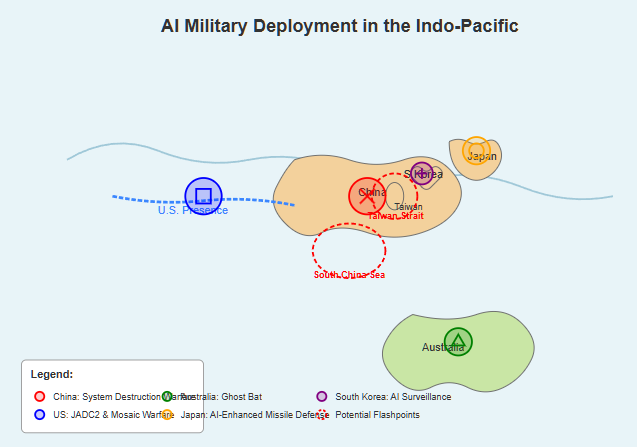
China’s AI Military Doctrine: System Destruction Warfare
China’s approach to AI-enabled warfare is grounded in a concept known as “System Destruction Warfare” (体系破击战)—a strategic doctrine that prioritizes paralyzing an adversary’s ability to fight by disrupting their entire kill chain, not just their physical forces.
At the heart of this doctrine is a focus on AI-powered systems designed to blind, jam, deceive, or disable an opponent’s C4ISR infrastructure—Command, Control, Communications, Computers, Intelligence, Surveillance, and Reconnaissance.
The People’s Liberation Army (PLA) is actively investing in:
- Autonomous drone swarms for high-volume saturation and sensor overload
- Cognitive electronic warfare, using AI to adaptively jam or spoof enemy systems in real time
- Machine learning models that optimize deception operations—manipulating how adversary AI perceives battlespace data
- AI-integrated space and cyber platforms capable of targeting satellites, comms, and networks
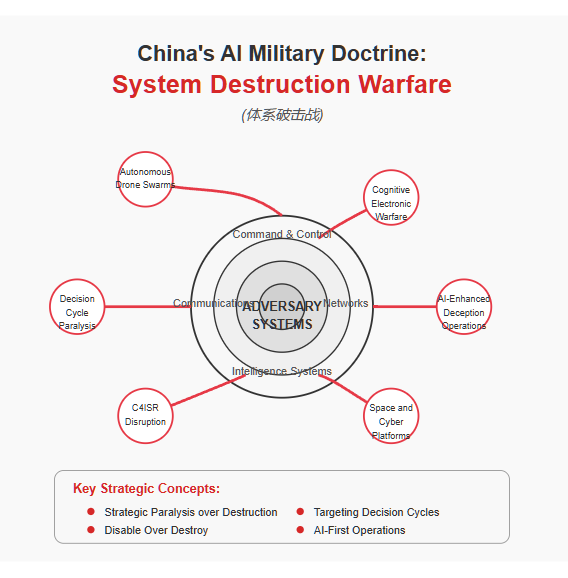
These tools are designed not for linear escalation, but for strategic paralysis—disrupting decision cycles and forcing adversaries into reactive postures.
Rather than mirror U.S. doctrine, China is building a disruption-first AI warfare model, where victory lies not in dominance, but in degrading the enemy’s ability to make coordinated moves.
In short, China is weaponizing AI not just to strike faster—but to ensure their opponents never get a clean shot.
The U.S. Response: JADC2, Mosaic Warfare, and AI Superiority
Faced with China’s disruption-focused doctrine, the United States is pursuing a counter-strategy built around speed, resilience, and integration—anchored by two major AI-enabled initiatives: JADC2 and Mosaic Warfare.
Joint All-Domain Command and Control (JADC2) aims to connect every sensor, platform, and shooter across the battlespace—air, land, sea, cyber, and space—into a seamless, AI-powered network. Its core objective: compress the decision loop so U.S. forces can observe, decide, and act faster than any adversary.
Key components include:
- ABMS (Advanced Battle Management System) for AI-driven ISR and decision support
- AI tools for real-time sensor fusion and target prioritization
- Integration of commercial space data, such as Palantir’s MetaConstellation
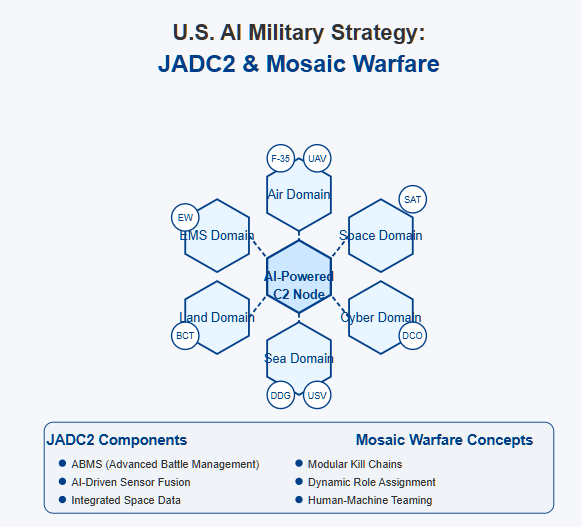
In parallel, DARPA’s Mosaic Warfare concept reimagines the kill chain as modular and reconfigurable. Instead of relying on fixed command structures, AI assigns battlefield roles dynamically—disaggregating functions across manned and unmanned assets.
The goal isn’t just speed—it’s flexibility under fire, with AI enabling human-machine teams to adapt instantly to degraded or denied environments.
In the Indo-Pacific theater, these programs are being operationalized by INDOPACOM, where contested airspace, maritime chokepoints, and limited reaction windows make AI decision dominance a strategic necessity.
Regional Allies: Australia, Japan, South Korea Join the Race
The AI arms race in the Indo-Pacific isn’t limited to China and the U.S. Key regional allies—Australia, Japan, and South Korea—are actively developing and deploying military AI systems to enhance deterrence, improve battlefield awareness, and prepare for autonomous threats.
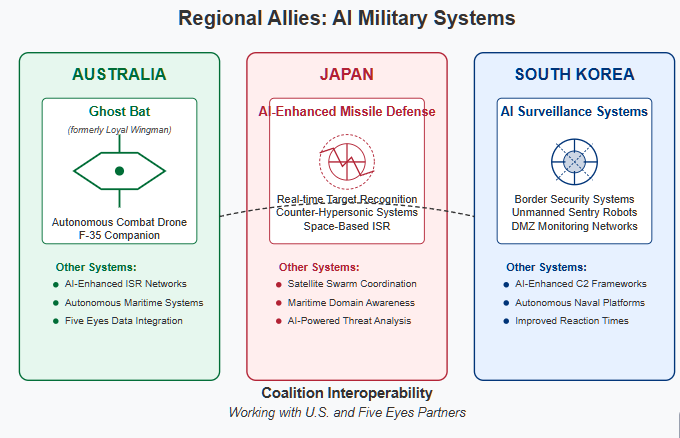
Australia
Australia has emerged as a key AI innovator with the Ghost Bat (formerly Loyal Wingman) program—an autonomous combat drone designed to operate alongside crewed fighters like the F-35. Developed with Boeing, it features advanced AI for formation flying, ISR tasks, and autonomous threat engagement.
Japan
Japan is investing in AI-enhanced missile defense and space-based ISR. Its Ministry of Defense has launched R&D programs for real-time target recognition, satellite swarm coordination, and AI-supported counter-hypersonic systems.
South Korea
South Korea is building AI-powered autonomous surveillance systems for border security, unmanned sentry robots, and is exploring AI-enhanced C2 frameworks to improve reaction times along the DMZ.
All three nations are working closely with the U.S. and Five Eyes partners to ensure interoperability and machine-speed coordination, especially in maritime and aerospace operations.
Together, these regional players are shaping an AI-enabled coalition posture—one that aims to deter aggression through speed, precision, and technological overmatch.
Flashpoints: Where the AI Arms Race Could Ignite
In a region as strategically dense and politically volatile as the Indo-Pacific, the convergence of autonomous systems and territorial disputes introduces a new category of risk: machine-speed escalation in contested zones.
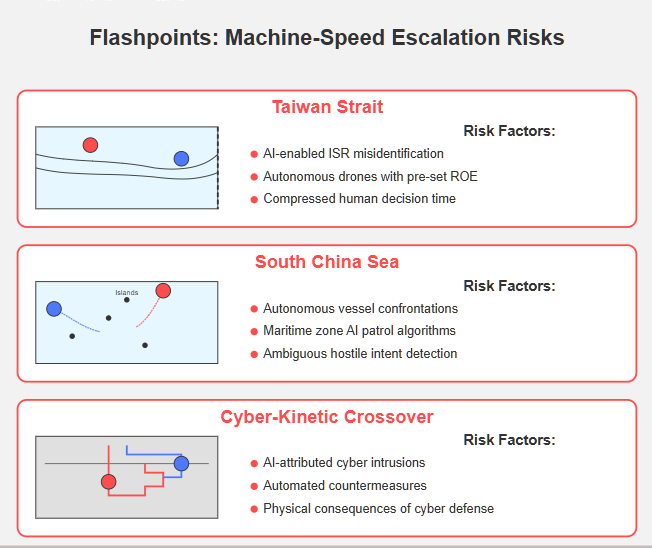
Taiwan Strait
Arguably the most dangerous flashpoint. The deployment of AI-enabled ISR systems and loitering munitions near Taiwan could lead to misidentification of aircraft or naval assets—especially during high-tension patrols. A false threat classification by an autonomous drone could trigger a kinetic response before diplomatic channels activate.
South China Sea
Heavily patrolled by unmanned vessels and AI-assisted surveillance networks. Incidents involving autonomous surface or underwater drones operating in disputed waters could quickly spiral—especially if an AI system interprets a close approach as hostile intent.
Cyber-Kinetic Crossover
China and the U.S. both run AI-enhanced cyber defense and offense systems. A major cyber intrusion—automatically attributed by AI threat models—could lead to automated countermeasures with physical consequences, such as jamming or drone strikes.
In these flashpoints, AI doesn’t just accelerate response—it reduces human decision time, increasing the risk of preemptive or miscalculated conflict.
Without shared norms or machine-to-machine communications protocols, a regional skirmish could turn into an autonomous engagement—before national leaders are even briefed.
The Arms Control Gap: No Treaties, No Timelines
Despite the rapid militarization of AI across the Indo-Pacific, there are no binding treaties or regional frameworks specifically addressing autonomous weapons systems, AI escalation thresholds, or machine-speed engagement protocols.
The Convention on Certain Conventional Weapons (CCW) under the United Nations has hosted years of debate on Lethal Autonomous Weapons Systems (LAWS), but the process has stalled—particularly due to opposition from major players like the U.S., China, and Russia.
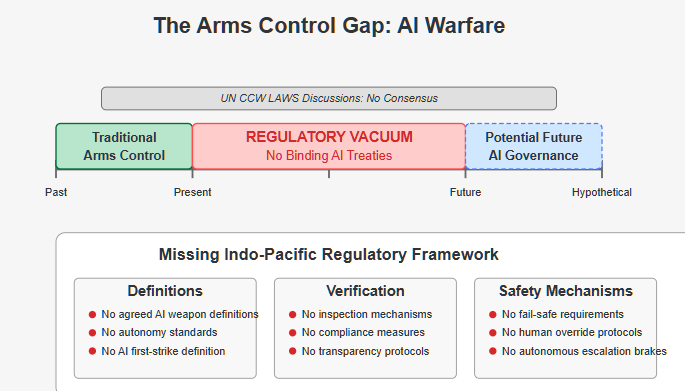
In the Indo-Pacific, where tensions already run high, this legal vacuum is particularly dangerous. There are no agreed definitions of what constitutes an AI-driven first strike, no shared mechanisms for AI fail-safes or override protocols, and no commitments to human-in-the-loop standards.
As AI capabilities scale, this lack of governance means nations are effectively racing to deploy autonomous systems without agreed rules of engagement—an arms race in speed, not stability.

Conclusion: Competing at Machine Speed
The Indo-Pacific is no longer just a contest of ships, missiles, and alliances—it’s becoming a theater for algorithmic warfare. Nations are investing in autonomous systems, AI-driven ISR, and real-time decision architectures not only to deter but to dominate.
But as the region races toward machine-speed military capabilities, it’s doing so without the necessary safeguards, treaties, or shared protocols. That gap turns every flashpoint—from Taiwan to the South China Sea—into a potential testbed for autonomous escalation.
The AI arms race in the Indo-Pacific isn’t hypothetical. It’s happening now.
And unless political and military leaders establish rules for how and when AI can engage, the first AI-accelerated war may be a matter of when, not if.
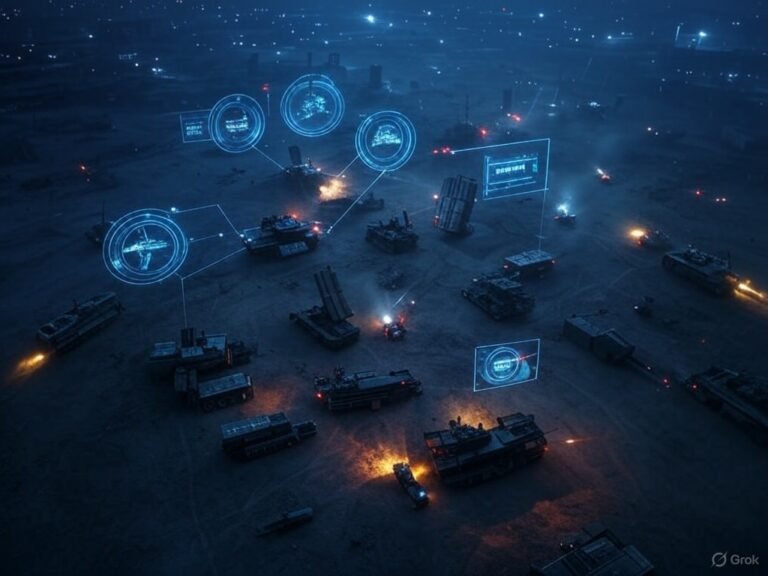
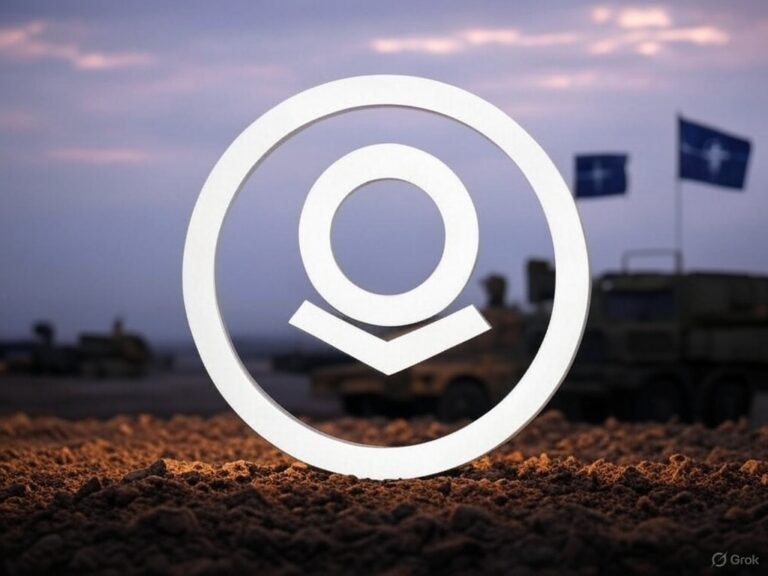

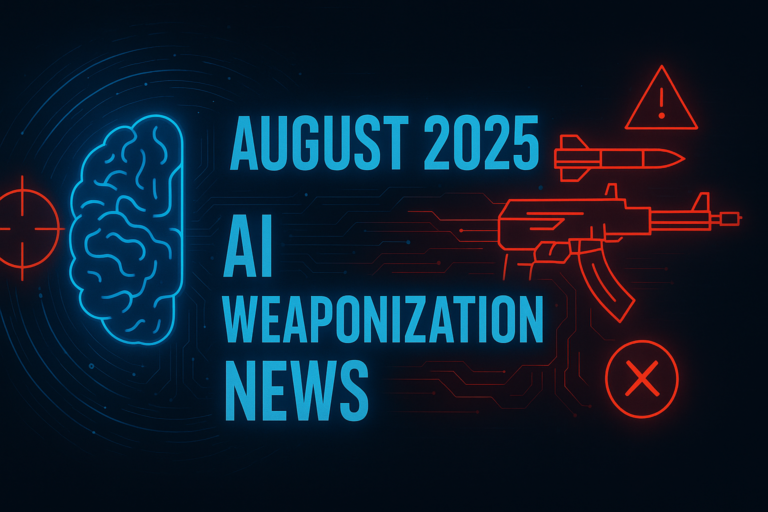

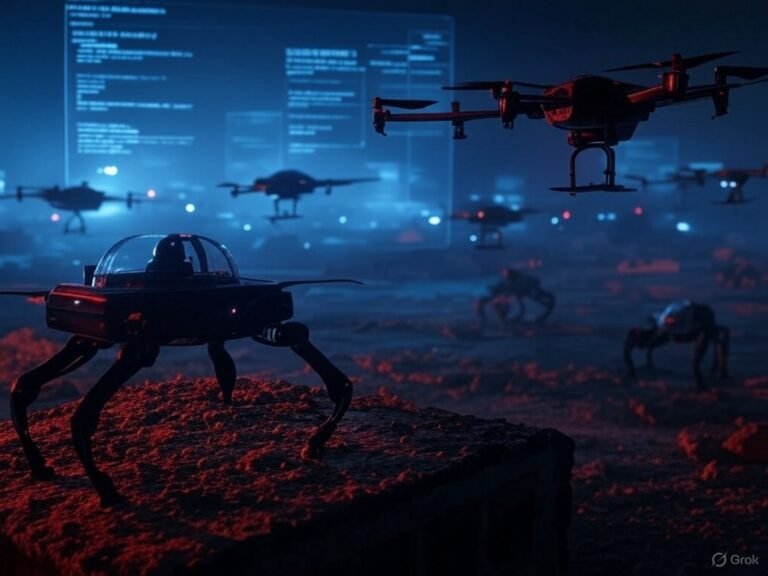

Great content – AI weaponization is the greatest threat we face.